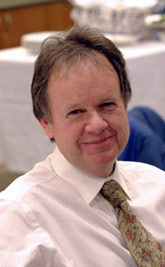
Handy Links
SLAC News Center
SLAC Today
- Subscribe
- Archives: Feb 2006-May 20, 2011
- Archives: May 23, 2011 and later
- Submit Feedback or Story Ideas
- About SLAC Today
SLAC News
Lab News
- Interactions
- Lightsources.org
- ILC NewsLine
- Int'l Science Grid This Week
- Fermilab Today
- Berkeley Lab News
- @brookhaven TODAY
- DOE Pulse
- CERN Courier
- DESY inForm
- US / LHC
SLAC Links
- Emergency
- Safety
- Policy Repository
- Site Entry Form

- Site Maps
- M & O Review
- Computing Status & Calendar
- SLAC Colloquium
- SLACspeak
- SLACspace
- SLAC Logo
- Café Menu
- Flea Market
- Web E-mail
- Marguerite Shuttle
- Discount Commuter Passes
-
Award Reporting Form
- SPIRES
- SciDoc
- Activity Groups
- Library
Stanford
Around the Bay
From the Director of Photon Science: Photon Science at SLAC—A Vision for the Future and First Steps

SLAC's transition to a true multi-program laboratory progresses at a very rapid pace. The remarkable success of the Linac Coherent Light Source and the discoveries that it will enable, the prolific delivery of science from the Stanford Synchrotron Radiation Lightsource and its impact on energy-relevant problems, and the seminal results coming from the Fermi Gamma-ray Space Telescope and the focus of the Particle Physics and Astrophysics Directorate in leading a diverse set of new experiments seeking to understand dark energy and dark matter, all provide very strong and positive evidence of SLAC's diversification and evolution in mission. At the core of this change, the new Accelerator Directorate is delivering excellence in support of accelerator operations coupled with advanced accelerator R&D. This is all being strongly facilitated by the progress in operations excellence in important areas of mission support.
So what about Photon Science at SLAC? In the words of SLAC Director Persis Drell, "To achieve its goal as a leading, internationally competitive laboratory in photon science, SLAC must strongly grow its portfolio of science performed at the laboratory, delivering on SLAC and Department of Energy mission needs and helping drive excellence in our scientific user facilities." The Photon Science Directorate is in the vanguard of delivering on this goal.
In the Photon Science Directorate, we perform excellent science in selected research areas, currently primarily aligned with DOE Basic Energy Science mission needs and often using and helping drive the experimental capabilities of LCLS and SSRL. However, we have a relatively modest portfolio of science performed at the lab, or "performing science," and scientific workforce, with an annual operating budget of less than $20M. Growing this performing science portfolio is an objective of SLAC and indeed Persis has set a goal of increasing it by about $100M (more than a factor of five-fold) by the end of the decade. At this week's annual review of SLAC's plans for the upcoming years, DOE reacted very positively to this aspiration.
Achieving this goal will be challenging and will require an organization well positioned for managing expansion, very careful strategic planning, targeted hiring of scientific talent and new space for experimental science at SLAC. SLAC and Photon Science leadership believed that the current organization of the Photon Science Directorate with the SIMES and PULSE joint institutes was too constraining to accomplish the objectives needed to achieve the target future growth. Further, the existing structure does not offer optimal alignment with current and especially future stakeholder interests.
After considerable discussion internally, with DOE, and review by Stanford's Scientific Policy Committee in May, we will reorganize the SLAC Photon Science Directorate into a new divisional structure. Initially, there will be two divisions—Chemical Sciences and Material Sciences. Our transition into this new structure is already underway and will be complete by the end of this fiscal year. The new divisional structure offers a natural way to align our current science portfolio in PULSE and SIMES with the Divisions of Materials Sciences and Engineering and Division of Chemical Sciences, Geosciences and Biosciences at DOE-BES.
Further, the divisional structure provides the framework for future diversification and growth in new directions. We see opportunities for expansion that could bring new DOE-funded research to SLAC, especially in the areas biosciences, advanced scientific computing and fusion energy sciences. Along with this will come increased opportunities for funding from other agencies such as the National Institutes of Health and National Science Foundation, which will further enhance core research capabilities that we have chosen to develop. We will retain the institutes/centers to focus in selected areas where a coherent approach enhances cross-disciplinary science and further strengthens and develops our connections to departments and research on the main Stanford campus. In a future SLAC Today article, I will describe the new organizational structure and associated organizational chart, the context of the institutes, and more specific plans for future development.
The words of physicist Robert Oppenheimer offer an inspiration for Photon Science in the future, "See things not as they are, but as they might be." We can capitalize on remarkable opportunities at SLAC, in strong partnership with Stanford and our other national laboratory and university partners, to develop a competitive performing research portfolio, delivering solutions in areas of some of the nation's most pressing problems in energy, the environment and human health.
